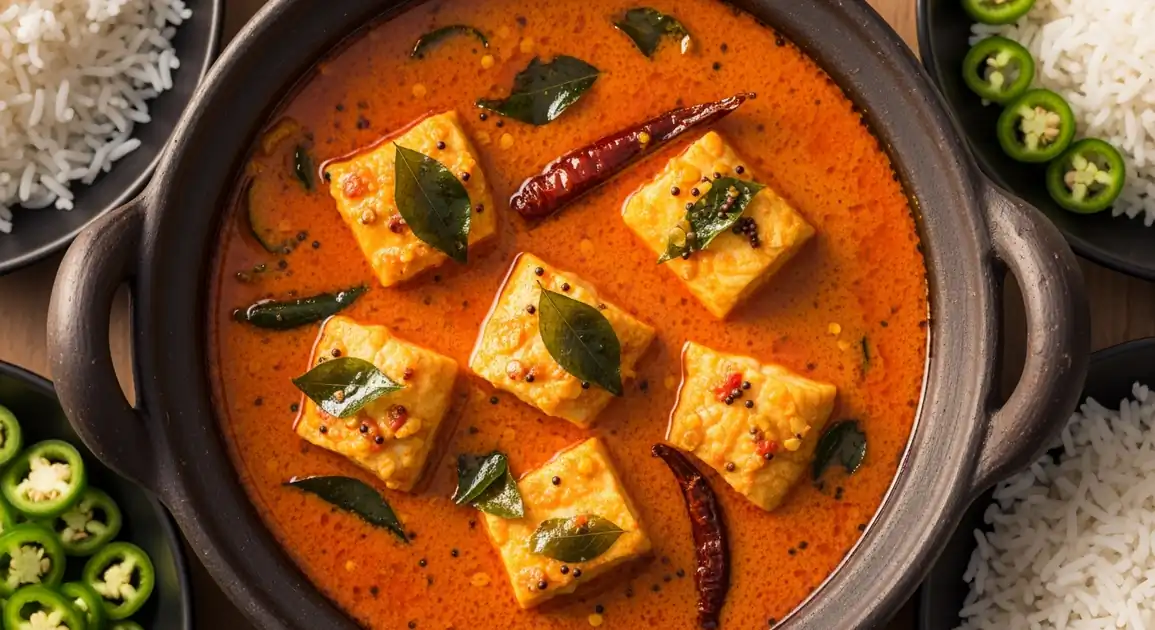Sri Lankan Fish Curry
මාළු කිරිබත් (Malu Kirihodi)

Description
Galle, a historic coastal city in southern Sri Lanka, offers distinctive fish curry reflecting its maritime heritage. Here, fish curry tends to be moderately spiced with prominent coconut flavor, often using freshly caught seer fish, snapper, or tuna from the town's active fishing harbor. The UNESCO World Heritage Galle Fort area features both traditional and upscale interpretations of fish curry.
Dietary Information
Serving information
Serving style
In local eateries, served as part of a rice and curry spread with several accompaniments. In upscale restaurants, may be served in individual clay pots with accompanying rice and garnishes. Traditional places may serve on banana leaf or lotus leaf for authentic presentation.
Quick facts
Local eateries: 7 AM - 3 PM. Restaurants: 11 AM - 3 PM for lunch, 6 PM - 10 PM for dinner. Places near the fish market may start serving from earlier morning hours (6 AM).
Safety Tips
What to Look For
-
Clear broth with natural oil separation on top
A thin layer of natural orange-red oil from coconut milk indicates proper cooking and prevents spoilage.
-
Fish pieces that hold their shape and are opaque white/pink
Properly cooked fish should be firm and fully opaque, never translucent in the center.
-
Aromatic fragrance with distinct curry leaf and spice notes
Fresh curry should have a complex aroma dominated by curry leaves, coconut, and warming spices, not a fishy smell.
-
Made to order or in small visible batches
Especially important in casual eateries; fish curry shouldn't sit for hours at room temperature.
What to avoid
-
Grayish or excessively broken fish pieces
Indicates old or repeatedly reheated fish, potential for bacterial growth.
-
Overly cloudy or curdled coconut milk base
Suggests the curry has spoiled or the coconut milk has fermented due to prolonged heat exposure.
-
Strong fishy or ammonia-like smell
Indicates the fish wasn't fresh when cooked or the curry has spoiled.
-
Unnaturally bright red or orange color
May indicate excessive coloring agents rather than natural spices.
Price information
Price range
Budget tips
- Local eateries outside the fort area serve authentic fish curry for 250-400 LKR.
- Small restaurants within Galle town proper charge 400-700 LKR.
- Upscale restaurants in Galle Fort may charge 800-1500 LKR for premium preparations.
- The fish market area has small 'kades' serving excellent value fish curry for around 300-450 LKR.
Value indicators
- Freshness of fish (firm texture, clean smell).
- Restaurant's proximity to the fishing harbor (generally fresher).
- Homemade rather than commercial curry powder.
- Natural (not artificial) coloring and proper consistency.
- Generous fish-to-sauce ratio.
Where to Find This Dish
Galle Fort
Historic walled area featuring both traditional and upscale restaurants serving refined versions of fish curry.
Old Dutch Hospital complex, Lighthouse, Ramparts
Lunch, Dinner
Galle Fishing Harbor/Market
Area surrounding the commercial fishing port with small eateries serving fresh fish curry made from morning catch.
Fish Market, Main Bus Station
Morning, Early afternoon
Unawatuna Beach Area
Beachside restaurants offering fish curry catering to both tourists and locals.
Unawatuna Bay, Jungle Beach access road
Lunch, Dinner
Vendor Tips
- Restaurants that promote 'daily catch' or 'fresh harbor fish' typically serve better quality fish curry.
- Establishments where you can see the fish before preparation (particularly in the harbor area) offer assured freshness.
- Ask if the curry is made with homemade spice blend (ideal) rather than commercial powder.
- Some places offer multiple spice levels - specify your preference when ordering.
How to Order
Regional Variations
-
Galle Harbor-style Fish Curry
(ගාල්ල වරාය මාළු කිරිය)
Distinctive to eateries near the fishing harbor, featuring the morning's catch with a balanced spice profile and medium-thick gravy.
-
Galle Fort Refined Fish Curry
(ගාල්ල කොටුව සියුම් මාළු කිරිය)
Upscale version found in Fort restaurants, often using premium fish cuts, less chili heat, and elegant presentation.
-
Southern Coast Fish Curry
(දකුණු වෙරළ මාළු කිරිය)
Common in the broader Galle region, featuring medium spice levels, prominent curry leaf flavor, pandan, and goraka sourness.
-
Coral Reef Fish Curry
(පරවාල මාළු කිරිය)
Specialty using smaller reef fish varieties like snappers, often with a thicker gravy to complement the more delicate flesh.
Cultural context
History
Fish curry has been a staple in Sri Lankan coastal communities for centuries, evolving from the abundant seafood resources surrounding the island. The current version, influenced by Portuguese, Dutch, and indigenous cooking methods, emerged during colonial times when new spices were introduced to the island. In southern coastal areas like Galle, the curry developed a distinctive character using local goraka fruit and fresh coconut, which were plentiful. Historically, it was cooked in clay pots (muthi) over wood fires, which many traditional establishments still do to maintain the authentic smoky flavor.
Local significance
Fish curry in Galle represents the city's centuries-old maritime heritage and the blending of Sinhalese, Tamil, Moor, and colonial influences that characterize the region.
Eating customs
- In traditional settings, eaten with the fingers of the right hand, mixing small amounts with rice.
- Often paired with coconut sambol (pol sambol) and a bitter green vegetable curry for balanced flavor.
- Local etiquette appreciates when guests request a second serving, indicating enjoyment of the meal.